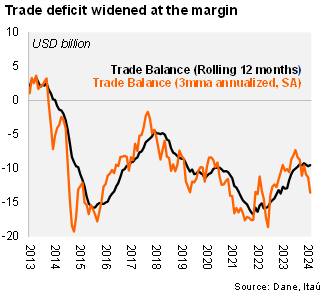The trade deficit came in at USD 0.6 billion in June, narrowing USD 0.1 billion over one year. The deficit was in line with the Bloomberg market consensus of USD 0.6 billion, but below our USD 1.1 billion call. During 2Q24 the trade deficit reached USD 2.5 billion (in line with the 1Q24 deficit). Overall, the rolling 12-month trade deficit reached USD 9.3 billion (USD 9.1 billion as of March; USD 9.7 billion in 2023). At the margin, our seasonal adjustment shows the trade deficit at USD 13.5 billion (annualized), up from the USD 8.4 billion recorded in 1Q24.
Imports increased sequentially in 2Q24. In the second quarter of the year, imports returned to positive territory after 18 months, increasing by 4.4% YoY (-10.9% YoY in 1Q24). Transport equipment (-53.1% YoY), materials for agriculture (-23.2% YoY) and fuels (-17.6%) were the main drags in the quarter, while consumption goods increased by 4.5% YoY. Imports excluding fuels and transportation equipment rose by 6.4% YoY (-7.7% YoY in 1Q24). At the margin, we estimate that imports increased 45.4% qoq/saar (-12.6% in 1Q24).
Non-traditional exports stagnated. During 2Q24, exports increased 3.4% YoY (9.2% drop in 1Q24), hampered by double-digit declines in coal and ferronickel, but countered by coffee, oil and agricultural exports. Oil exports in the quarter increased by 10.7% (-0.8% in 1Q24). On the other hand, coal exports contracted by 21.9% (-37.1% in 1Q24). Exports excluding traditional goods (oil, coal, coffee, and ferronickel), accounting for 46.6% of total exports, fell by 0.6% YoY). At the margin, exports increased 3.7% qoq/saar (-17.7% in 1Q24; +17.9% in 4Q23).
Our Take: Contractionary monetary policy and high inflation should keep domestic demand soft. We expect the current account deficit to remain low at 2.7% of GDP this year.

